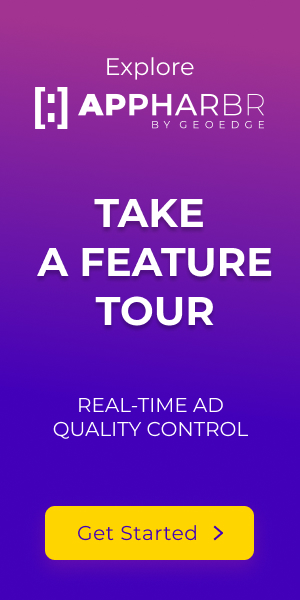In today’s digital ecosystem, publishers are offered a range of in-app ad formats. From interstitial and native ads to leaderboard ads, these formats offer benefits that can supercharge monetization. GeoEdge research reveals, The secret to achieving success in in-app advertising lies in ensuring high ad quality.
Research by GeoEdge reveals that 69.23% of app publishers noticed a negative impact on their mobile users due to poor ad quality. Furthermore, for 71%, poor ad quality has prompted their app users to uninstall their apps, a frustrating outcome given the high cost of user acquisition campaigns.
App publishers can create a seamless and rewarding experience by identifying and proactively addressing quality issues. In this article, we’ll explore the best practices for enhancing engagement and nurturing loyal users.
A Look at In-App Advertising Risks
There’s a pressing need to deal with misleading content in in-app ads, a challenge that, unfortunately, is quite prevalent. Deceptive or manipulative ads can lead to severe consequences, from decreased revenue to a degraded user experience and even harm to the brand’s reputation.
Inappropriate ad sizes are another concern requiring immediate attention. Ads that don’t adhere to the recommended size standards disrupt the aesthetics of the app interface, compromise the ad’s visibility and legibility, and frustrate users.
Additionally, the phenomenon of ad clutter deserves attention. The overabundance of ads within an app can backfire, leading to user fatigue and disinterest. Presenting too many ads within a short span could cause users to feel bombarded, triggering disengagement and potentially lowering the CPMs.
Tips to Maximize the Impact of Ad Formats
Once apprised of the risks and common quality issues, the question is—how can these be addressed effectively?
Ensuring high ad quality hinges on constant vigilance and control. Taking proactive steps to identify and address low-quality ads is essential.
- Investing in reliable ad quality control tools and uphold transparency and proactively filter malicious, unwanted and offensive ads, before users see them.
- Ensuring International Ad Bureau (IAB) standards is essential for addressing ad size issues. Publishers should commit to diligently optimizing ad dimensions and layouts, ultimately achieving a harmonious balance between user experience and revenue generation.
- Embracing responsive ad designs that cater to various screen sizes is an instance of proactive adaptation.
- Strategic ad frequency capping can alleviate user fatigue caused by ad clutter, especially when users feel bombarded by excess ads in a short timeframe.
- Thoughtful ad placement within the app and employing user-profile data for personalized ad targeting can enhance user engagement.
Tackling these challenges extends beyond improving the visual aspect of ads or focusing solely on technical accuracy. Indeed, the emphasis should be on adopting a user-centric perspective.
Publishers foster user loyalty by collecting and enforcing to the audience’s feedback, adjusting advertising strategies to align with their preferences, and consistently delivering high-quality ad experiences. This, in turn, propels stable and significant payoffs for the publisher’s brand.
Poor positioning can lead to accidental clicks due to “fat fingers,” which hurts the UX and unintentionally sends users out of your app.
Avoid unexpected behavior that hurts UX, such as banners that expand, flash, play sound or in-banner video, make the phone vibrate, etc.
Risks of Video Ad Formats
In-app video ads have caught the attention of targeted demographics, making them an increasingly popular choice among publishers and advertisers. But this format comes with its compliance requirements.
Inconsistent quality standards often plague in-app video ads, particularly when content sidesteps community norms or misaligns with target audience expectations.
Unexpected video playback, driven by intrusive autoplay characteristics, can disrupt users consuming the content. Furthermore, long buffering due to sub-optimally optimized videos may incite user dissatisfaction and diminish engagement.
Best Practices to Keep Video Ads User-Friendly
To adeptly navigate these intricacies, leveraging validated best practices can be beneficial, providing a framework to secure ad quality and compliance.
- An approach that favors strict moderation of ad content is recommended as it aligns with established guidelines and audience preferences.
- User-centered playback functionalities can also be beneficial to offset the intrusive nature of autoplay settings. When users can pause or mute videos, it can bolster their control, enhancing the total ad experience.
- Employ technical enhancements and best practices such as adaptive bitrate streaming, caching, and optimized encoding to optimize video buffering times and deliver a smooth, high-quality app experience.
Putting these best practices into action can empower publishers to realize the potential of in-app video ads fully. At the same time, they can effectively tackle compliance and quality considerations while bolstering user trust and credibility.
Avoid These Native Ad Format Fails
Native advertising ensures a subtle blend with an app’s content structure, creating a harmonious user experience and increased engagement. Nevertheless, this approach has several challenges that require careful consideration and handling.
Firstly, there’s misleading disclosure, where the discreet nature of native ads obscures their identification as promotional content, potentially leading to user confusion or deception.
Secondly, deceptive practices where ad content inaccurately represents the product or service pose another risk, shaking the foundation of the publisher’s brand’s credibility.
Tips to Make Native Ads Work
- Successful native advertising rests on making a clear demarcation between native ads and editorial content, preventing ambiguities about content origin and nature, thereby preserving user trust.
- Following the Federal Trade Commission (FTC) guidelines for native advertising is crucial. These guidelines are designed to protect consumers and ensure fair business practices.
- Choosing reliable ad partners who adhere to industry norms and best practices is also a significant consideration. These partnerships will ensure native ads achieve their central goal of enhancing user experiences rather than detracting from them.
The Dangers of Interstitial Ad Formats
Interstitial ads have marked their presence in the dynamic in-app advertising space with their potent potential for user engagement and viewability. However, implementing them presents opportunities and challenges, necessitating strategic foresight and acknowledgment of inherent risks.
Interstitial ads can be intrusive if unchecked. These full-screen ads can demand excessive user attention, leading to ad fatigue, increasing user drop-off rates, and negatively affecting overall engagement and revenue. Other challenges include quality issues directly tied to achieving optimal ad performance.
Avoiding Interstitial Ad Format Risks
Striking a delicate balance between engagement and annoyance is necessary to prevent user disengagement.
- Well-limited ad frequency can shield users from overwhelming exposure, mitigating ad fatigue.
- Ensuring efficient load times–a determinant of smooth ad performance–can prevent disruptions in user interactions.
Balancing the financial benefits of serving interstitial ads with assuring a quality reading experience may seem daunting, but strategic planning of ad campaigns can dissolve this challenge. The alignment of ad placements with natural breaks in app usage can mask the intrusive perception while enhancing.
Ensure they’re skippable; otherwise, they put the user in a deadlock and effectively end the session.
Take Charge of Ad Quality with AppHarbr by GeoEdge
AppHarbr empowers app publishers with the vital tools needed to protect their audience’s experience and solidify user loyalty. Through active ad quality protection, AppHarbr enables publishers to boost their apps ROI by blocking unwanted ads and advertisers who cause user churn, complaints, and low ratings.




